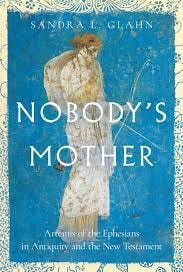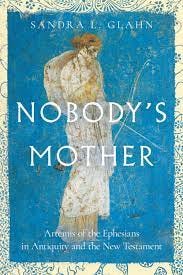Guest post by Sandra L. Glahn, author of Nobody’s Mother: Artemis of the Ephesians in Antiquity and the New Testament.
When a woman goes into labor these days, friends and relatives usually cheer, celebrate, and bring gifts. But in first-century Ephesus, such celebrations would have been tempered by trembling, appeasing idols, and offering gifts to gods—especially Artemis. Whereas childbirth is always risky, childbirth in the ancient world was positively deadly. Childbirth was the number-one killer of women ages 15-29.
By the time of the apostle Paul, the temple to Artemis in Ephesus was the crown jewel of the world’s Seven Wonders. After a fire, it was rebuilt to stand at three times the size of the Athens Parthenon. And this Artemisium was a frequent site of offerings and prayers for a safe delivery. According to Homer, Artemis was the illegitimate daughter of Leto and Zeus, twin sister of Apollo, goddess of the hunt, and a confirmed virgin. But she took on additional characteristics based on location. In the same way, Barbie can be an astronaut, an archaeologist, and the US president, Artemis could have differing personas in different cities. And in Ephesus, Artemis was more than a virgin arrow-sporting goddess of the hunt. She was also connected with midwifery.
Many associate “midwife” with “fertility, mothering, and nurturing.” Such is the case with Artemis in Ephesus. Add to this that the statue of the Ephesian Artemis had bulbous appendages on her bodice, and it’s easy to see why many have described her as a mothering fertility goddess. Although these appendages are more likely Hittite magic pouches, people often mistake them for breasts.
In the same way that midwives and obstetricians deal with delivery but not sex, fertility, mothering, or nurturing, Artemis dealt only with delivery. In fact, in one ancient story, someone mocked Artemis and Apollo because their mother, Leto, delivered only two children while the goddess Niobe had ten. In revenge, the twins shot arrows through all ten of those children—Apollo killing the sons, and Artemis taking out the daughters. Unlike the modern-day Wonder Woman who champions females, Artemis of Ephesus was as ruthless with women as with men. Sometimes more so.
So how did Artemis Ephesia come to be associated with childbirth? She witnessed her mother’s multi-day travail in delivering her twin, Apollo, near Ephesus. So Artemis began to be associated with midwifery especially in that locale. Plutarch (A.D. 46–120) wrote, “Alexander [the Great] was born…the same day that the [first] temple of Artemis at Ephesus was burned.” The temple, he says, “took fire and was burnt while its mistress was absent, assisting at the birth of Alexander.” Members of the pantheon are not omnipresent, so she prioritized Alexander the Great’s birth over protecting her own temple.
In this role as midwife, Artemis Ephesia was believed to have the power to deliver a first-century woman through the most dangerous of passages—childbirth. And though not a man-hater, Artemis was a confirmed virgin. Amazon women are said to have identified with her. And her priestesses and cult leaders appear to have been virgin girls, sexually inactive wives, and widows. Still, her devotees included men. Some were even named after her. In Paul’s epistle to Titus, he endorses someone named Artemas (Titus 3:12), which means “follower of Artemis.”
What difference does it make?
Students of Scripture can see a link between the religious context in Ephesus as described in Acts 17 and the book of 1 Timothy. Acts describes magic workers burning their wares followed by a disturbance led by silverworkers devoted to Artemis. The latter felt the gospel hurt their sales. And Paul writes to his protégé Timothy in Ephesus with instructions to stop false teachers from teaching (1 Timothy 1:3). Some of the language Paul uses he borrows from the Artemis lexicon, as it were. Savior. Lord. Manifest. First. God. All of these titles appear in inscriptions that refer to Artemis. But Paul emphasizes them in reference to Jesus Christ.
Knowing what we do about the influence of the Artemis cult in Ephesus, we can see a connection between the abstinent lifestyle referenced in Paul’s epistle. Think “young widows,” old widows, widows causing difficulty, widows needing to marry and have children, and people forbidding to marry (1 Tim 4:3). This emphasis on the unmarried state helps explain why Paul, when writing to over-sexed Corinthians would say widows should consider celibacy (1 Cor. 7:8), but when writing to his protégé in Ephesus, he wants younger widows to marry and have children (1 Tim. 5:14). Understanding the background can also explain why Paul would emphasize that Adam was first. Paul is likely correcting their local creation story with the true creation story. And such a correction points to the most important reality: Jesus is better.





I can’t wait to dig into this book. I’ve long suspected that the veneration of Mary originated in Ephesus, given the city’s focus on Artemis along with the tradition that she spent her final days there in the care of John and the extended Christian community.